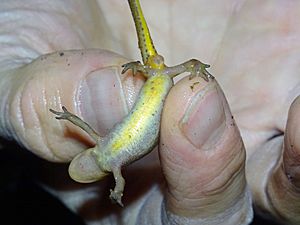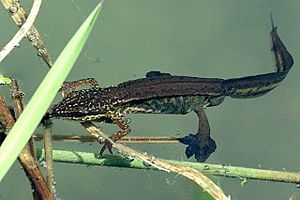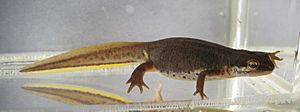Palmate newt facts for kids
Quick facts for kids Palmate newt |
|
|---|---|
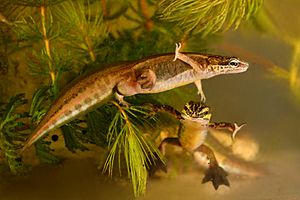 |
|
| Two breeding males | |
| Conservation status | |
| Scientific classification | |
| Genus: |
Lissotriton
|
| Species: |
helveticus
|
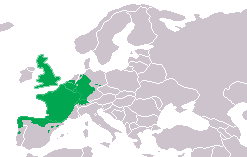 |
|
The palmate newt (Lissotriton helveticus) is a type of newt found in Western Europe. You can find it from Great Britain all the way to the northern parts of Spain and Portugal. These newts are usually about 5 to 9.5 centimeters (2 to 3.7 inches) long. They are olive green or brown with some dark spots.
Their belly is yellow to orange. Unlike the similar smooth newt, the palmate newt's throat never has spots. A dark stripe runs along its head and through its eyes. When males are ready to breed, they grow a special filament (a thin thread-like part) on the end of their tail. Their back feet also become strongly webbed, and they get a low, smooth crest on their back.
Palmate newts live in many places, like forests, marshes, fields, or gardens. When they are on land, they are mostly active at night. In spring, after sleeping through winter, they move to still water bodies that don't have fish. This is where they breed. After a special courtship display, the male leaves a packet of sperm for the female to pick up. Young newts (larvae) grow for about 1.5 to 3.5 months. Then, they change into land-dwelling juveniles, called efts. They become adults in two to three years and can live up to 12 years in the wild. This newt species is common and is listed as "Least Concern" by the IUCN. This means they are not currently at risk of disappearing.
Contents
About the Palmate Newt's Name
The palmate newt was first described by a Russian scientist named Grigory Razumovsky in 1789. He first thought it was a type of green lizard and called it Lacerta helvetica. The word "helvetica" comes from "Helvetia," which is the Latin name for Switzerland. This is because the first newt he studied came from Switzerland.
Over time, scientists learned more about newts. They realized this newt was not a lizard. It was placed in different groups (genera) of newts. For a while, it was part of the Triturus genus, which included most European newts. But in 2004, scientists found that the Triturus group was too broad. They decided to put the smaller newts, like the palmate newt, into their own group called Lissotriton. This name was first used by an English scientist, Thomas Bell, in 1839.
What Does a Palmate Newt Look Like?
Male palmate newts usually grow to about 5 to 8.5 centimeters (2 to 3.3 inches) long. Females are a bit bigger, reaching up to 9.5 centimeters (3.7 inches). Their tail is a little shorter than their body. The head is longer than it is wide.
Both male and female newts are olive green or brown. Males and some females have dark spots on their backs. Sometimes, females have two wavy lines of spots. When they live on land, females can also have a red stripe down their back. Both sexes have a dark stripe that goes through their eyes.
Their belly is yellow or light orange, turning whitish on the sides. The belly might have some dark spots, but the throat is always clear of spots. When newts are on land, their skin feels dry and soft like velvet. But when they move into water for breeding, their skin becomes smooth.
You can tell males from females by looking at their cloaca (a body opening). Males have a larger and darker cloaca. During the breeding season in water, the male's cloaca swells up. Other changes happen too. Males grow a low, smooth skin ridge (a crest) on their back, which is higher on their tail. Their tail also has a blunt end with a special thread-like part, about 4–7 mm long.
Males also have ridges along their sides, making their body look square-shaped. Their back feet develop dark, strong webbing. The bottom half of the male's tail turns blue during breeding. Females do not grow a crest, tail filament, or webbed feet. Their lower tail is orange.
Palmate newts are sometimes confused with the smooth newt. Both live in many of the same areas. But you can tell the palmate newt apart because its throat is never spotted. It also looks a bit like Bosca's newt from Spain and Portugal. However, Boscá's newt only has one groove on its snout and no dark stripe through its eye.
Where Palmate Newts Live and Their Homes
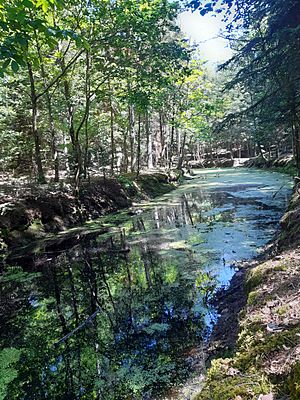
The palmate newt lives in Western Europe. Its range goes from Great Britain (even up to Scotland) down to northern Portugal and Spain. To the east, it reaches the Elbe river in Germany and the Czech Republic. It also lives in the lower and middle parts of the Alps in Switzerland.
These newts are most common at heights of 500 to 1500 meters (1,600 to 4,900 feet) above sea level. But they can be found from sea level up to 2500 meters (8,200 feet) in the Pyrenees mountains. Scientists believe that during the last Ice Age, these newts lived only in Spain and Portugal. Then, they spread north after the ice melted.
Palmate newts are common in most places they live. They can be found in many different habitats. These include forests, marshes, and pastures. They are less common in farmed areas but can live in gardens. For breeding, they like different types of still water bodies. They prefer ponds without fish, and they can even live in acidic ponds.
The smooth newt lives in many of the same areas. But in France, smooth newts seem to prefer ponds in open fields. Palmate newts, however, prefer ponds in forests. It's rare to find hybrids (mixes) between these two newt species.
Lifecycle and Reproduction

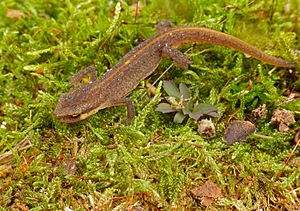
Palmate newts usually breed from February to May. In warmer southern areas like Spain and Portugal, breeding can start earlier or last longer. This depends on how high up they live. Newts can use the Earth's magnetic field to find their breeding ponds from far away. They also use frog calls to find ponds when they are closer. Once in the water, they are active both day and night.
Breeding involves a special dance, or courtship display, just like with other newts. The male tries to attract a female by swimming in front of her. He sniffs her cloaca. Then, he vibrates his tail against his body, sometimes lashing it. This fans special chemicals (pheromones) towards her. In the last part of the dance, the male leaves a packet of sperm. He then guides the female over it so she can pick it up with her cloaca.
The female lays 150 to 440 eggs one by one on water plants. The eggs are 1.3–1.8 mm wide (2.2–3 mm with their protective cover). They look very similar to smooth newt eggs. Young newts, called larvae, hatch after 8 to 21 days, depending on the temperature. They are 8–14 mm long when they hatch.
Young larvae are yellow-brown with two black stripes. They have two small parts (balancers) on the sides of their head, which disappear later. Their color then changes to help them blend in. The larvae grow to 3–4 cm (1.2–1.6 inches). They change into land-dwelling juveniles (efts) after 1.5 to 3.5 months. Some larvae stay in the water over winter. Sometimes, adult newts keep their gills and stay in the water their whole lives. This is called paedomorphism.
Young efts live on land until they are old enough to reproduce, which is usually in their second or third year. On land, they are mostly active on humid nights. Palmate newts usually sleep through winter (hibernate) on land. But sometimes they hibernate in the water. In Spain and Portugal, they are often active all year.
Larvae, efts, and adult newts mostly eat different small creatures without backbones, like insects. But sometimes, newts will eat each other, especially larvae eating eggs. Palmate newts can live up to 12 years in the wild.
Threats and Conservation
Overall, the number of palmate newts is not going down. The IUCN has listed them as "Least Concern." This means they are not in danger of extinction right now. In France, it is the most common newt species. However, it is rare in Belgium and the Netherlands. In Spain and Portugal, their groups are spread out.
The palmate newt is included in some national and local "red lists" of endangered species. Some dangers to newts include draining and polluting their breeding ponds. Also, introducing fish and crayfish to their ponds can be a problem. In southern areas, dry weather (desertification) is also a threat.
Like all amphibians, the palmate newt is a protected species under the Berne Convention (Appendix III). It is also protected by law in the countries where it lives.
See also
 In Spanish: Tritón palmeado para niños
In Spanish: Tritón palmeado para niños




